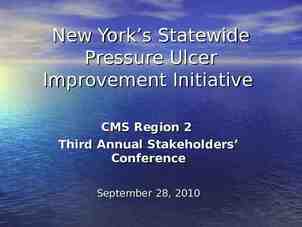What is Applied Behavioral Analysis (ABA) and How it is
29 Slides1.29 MB
What is Applied Behavioral Analysis (ABA) and How it is Applied Richard M. Foxx, Ph.D .
2
Science Science builds consensus because the nature of its proofs makes dissent so difficult. The path to consensus via science is rarely straight; it can take years to achieve and the battles can be bloody. But eventually, the accumulation of evidence is hard, even impossible to ignore (Finn and Martin, 2007) 3
Science Direct testing of questions and hypotheses. Operational definitions. Measurement — direct, accurate, reliable, objective. Controlled experiments to rule out alternative explanations. Conclusions, implications, predictions based on data. Replication is paramount. 4
ABA and the Treatment of Autism: The Evidence 40 years of success with individuals of all ages. 45 years of success treating children. More than 1,000 peer-reviewed, scientific articles reporting success. Over 40 years of NIMH funding of Applied Behavioral Analysis (ABA) research. Agencies have been using ABA as the dominate intervention for more than 30 years, providing nonresidential and residential education/treatment for thousands of children. All individuals benefit. 5
ABA and the Treatment of Autism: The Evidence Only educational/treatment approach supported by the state of New York Health Department (1999) and the United States surgeon general (1999). Meets the areas of agreement for effective intervention in autism. No other treatment/educational approach meets the same standards of scientific proof. No other treatment/educational approach produces similar clinical outcomes. 6
ABA and the Treatment of Autism: The Evidence Competency requirement guidelines for delivery of ABA services are well established (ABA-International Autism Special Interest Group). Levels of certification of ABA practitioners have been in existence since 1999 (Behavior Analyst Certification Board). Investing in early intervention ABA is financially worthwhile, whether the results lead to complete or partial effects (Jacobson, Mulick and Green, 1998). 7
Eclecticism is not the Best approach to the Treatment of Children with Autism The eclectic practitioner is often an apprentice of many models but master of none (Heward, 2003). A little bit of everything and a lot of nothing often reduces eclecticism to a recipe for failure (Kauffman, 1997). Adding ineffective treatment(s) to an effective one may be detrimental (Smith 2005). 8
Eclecticism is not the Best approach to the Treatment of Children with Autism The more models represented, the greater the likelihood of including ineffective and possibly harmful components. The most important and effective parts of each model might not be selected. Some components of a model may be ineffective when implemented in isolation. Elements from different models may be incompatible. An eclectic mix might prevent any model from being implemented continuously or intensively enough to obtain significant effects. 9
The Science of ABA Interventions Developed in the laboratory. Derived from learning principles. Systematically applied. Geared to create or improve socially significant behavior. Geared to decrease or eliminate maladaptive behavior. Require experimental demonstrations proving responsibility for the improvement in behavior. 10
Components of Comprehensive ABA Program Individualized behavior assessment and goal selection. Behaviors assessed in all domains, gross motor skills, selfhelp, independence, receptive language, expressive language; nonproductive behaviors that interfere with learning. Updated on continual basis. Goals selected by parents, therapists, and other professionals. 11
Components of Comprehensive ABA Program Operational definitions, measurement procedures, generalization and maintenance of treatment effects. Data collection on every program. Major emphasis on accountability. 12
Model 13
Dr. Foxx Contacted by PerformCare to address the needs of “at risk” children and adolescents by: Facilitating the transition back home from a hospital or residential setting. Preventing a placement into a hospital or residential setting. Addressing family crises that arise from behavioral concerns. Makes initial assessment. Assigns behavior analyst as consultant. Oversees treatment decisions and progress. 14
ABA Consultants: The Many Hats We Wear Gather information and set goals. Collaborate with multiple systems across several organizational levels. Advocate for the family regarding services. Design treatment protocols, teaching strategies, and data collection systems. Train others. Fade involvement. 15
Families The X factor: The buck stops here. Applying the scientific approach to family dynamics without losing compassion. Social skills are essential for a good consultant. 16
Providers Administrators and supervisors. Behavioral Specialist Consultants. Therapists. Therapeutic Staff Support. 17
School Systems Department of Public Education. School districts. Special education: The teacher. The aide. The therapist. 18
Private Facilities Private schools. Hospitals. Residential facilities. Private therapists and consultants. 19
When the Rubber Hits the Road Cooperation vs. suspicion. – Cooperation: Severe behavior breeds a desire to accept help. Various agencies are more likely to collaborate. – Suspicion: Previous therapeutic failure/inertia creates suspicion. Authorities within agencies can be hesitant regarding outside consultants. 20
PerformCare Cases Examples of the successful treatment of severe behavior. 21
Severe Behavior and IEP Objectives Severe Behavior vs. I EP Objectives 120 475 450 425 400 Total severe behavior Cumulative number of I EP objectives mastered 100 375 350 80 325 300 275 250 60 225 200 175 40 150 I EP Objectives N um ber of Severe Behaviors 500 125 100 20 75 50 25 0 0 Weeks 22
Caveats Don’t rush in to prove yourself. Look for an adult in the room or at the table. Pick your battles. Recognize you work for an organization and owe the organization your loyalty but keep one foot in and one foot out. Make a simple change that produces an observable outcome. 23
Caveats Recognize that your heart will be broken. The nice thing about telling the truth is you don’t have to remember what you said. Most people care and want to do a good job. Sleeping dogs will bite you. Walk in others’ moccasins. It doesn’t matter how good you are if you have bad social skills. 24
Caveats Reinforcement applies to typical adults. Don’t exceed your skill level. Less is more. Avoid recipes. Programming: 10% is knowing what to do; 90% is getting people to do it. Programming: No one conducts it for very long if it is not working. 25
Caveats Extinction – Easy to recommend; hard to do. Active programming is like playing chess. Changing behavior is like a pas de deux. How useful you are must outweigh how annoying you are. Success truly does breed success. 26
Caveats How to know parents are happy with you and your handling of their child’s case: They become more realistic in their expectations because they know there will always be progress. Meetings don’t last more than one hour. Other staff are more relaxed around them. The ITPS process begins to work as it was originally intended. 27
Caveats How to know parents are happy with you and your handling of their child’s case: – They get to act like parents. – They focus on very minor concerns because the big ones are being taken care of. – They don’t act suspicious. – They become selective as to when they contact you. – Their family begins having more of a life. 28
Thank You


































